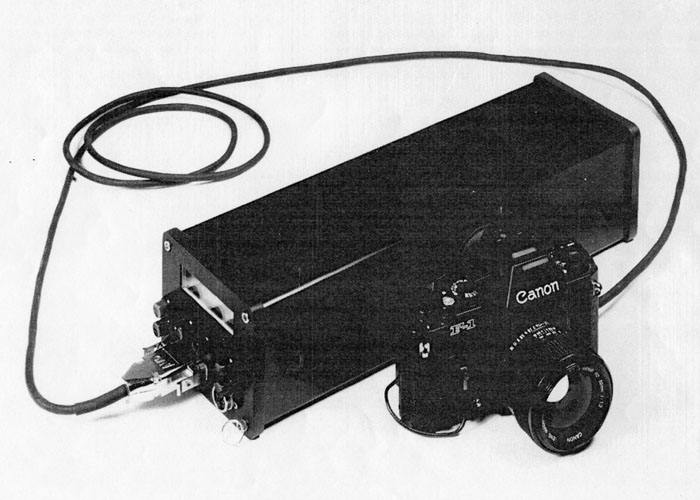
The Electro-Optic Camera got some people thinking at FSD. As soon as that camera was completed in early 1988, we built two of these Tactical Cameras that we could demonstrate to other customers, in hopes of creating a new market.
This more rugged model had no hard drive. Images were stored in DRAM as long as the battery lasted! A standard SCSI port on the back end, and a standard NTSC video connector on the front made it easy to get to the images.
The picture above is from a photocopy of the "sell sheet" for the camera. It's the only original picture I have of the complete camera.
The picture below is of the unit in 2012. Bruce Crosman tracked down and rescued this and several other old cameras, just days before they would have been in the dumpster. After many years, I was delighted to get my hands on this camera again. The unit still works, though without a camera body, I don't know if it will image very well. This system is now in the Eastman Museum collection.
The black box shoulder pack is a heavy aluminum extrusion. Very rugged. Very heavy. The back shown here is a spare one that I kept. Bruce didn't find the one that went with the black box. The round connector is for DC in and NTSC video out.
Black boxes hold mysteries, so let's open it up!
First we pull the rear cover. The SCSI connector is the way to get the digital images out. We can see a lot of DRAM in there. In the interest of ruggedness, this camera has no hard drive. The 16 Megabytes of DRAM will hold 12 high res images.. at least as long as the battery holds out! At the 640x480 resolution, the memory will hold 48 images. With a Canon motor drive on the F-1 body, those 48 frames can be captured in less than 10 seconds.
Next, we open the front cover. With the SCSI connector unplugged, it's easy to push the boards out from the back. We can also spot a lead acid camcorder battery nestled in the middle. The little board in the front was a later addition - a power supply for an external video monitor.
Here's all the guts laid out. Four wire-wrap boards full of goodies. The upper left board holds an Intel 80C196 16 bit microcontroller, running at a blazing 24 Mhz. There's an EPROM for the firmware, and an SRAM/clock chip with a very dead lithium battery built in. The Power General DC/DC converter provides the 5 volt logic power from the 12 volt battery.
The upper right board holds the digital logic and the big SCSI interface chip. The two little EPROMs in the middle are part of a micro-programmed state machine that controls the DRAM cycles, address counting and data transfer for image capture, video generation and SCSI output.
The lower right board holds all the DRAM.
The lower left board has the analog circuitry. This camera, like the Electro-Optic, sends analog CCD output down the cable to the shoulder pack. This board holds a switchable gain amplifier (for high and low res), the black clamp circuit and the 8bit A/D converter, right in the middle. Later, we moved the A/D converter to the camera body, to minimize analog signal degradation.
Tom McCarthy wire-wrapped these cameras and did a lot of other microsurgery when things didn't fit, or changes had to be made. Mark Prescott modified the SCSI interface firmware to record to an Exabyte drive, like the Electro-Optic Camera.
Todd Gustavson, technology curator at the Eastman Museum, had a replacement focus plate fabricated, and obtained a Canon body and other parts to complete the unit, and it is now on display at the museum. Here's the camera as assembled and displayed in 2013.